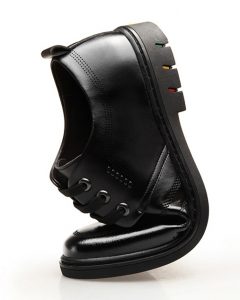When it comes to leather shoes, there are many factors to consider when it comes to quality. This article mainly discusses how to distinguish high-quality leather shoes from low-quality leather shoes from the aspects of outsole, leather core, glue, inner sole, main heel, toe cap and the overall quality of shoes.
First of all, the outsole of leather shoes is a key factor in determining its quality. The material used for the outsole, such as lemon gum, polyurethane or modified PVC, plays an important role in determining the durability of the shoe. The national industry standard for leather shoes stipulates that the outsole must have folding resistance, wear resistance, and hardness, and these elements should be evaluated using testing equipment. In addition, when trying on shoes, it is best to press the soles with your fingers to check whether the quality is qualified. It should be noted that the quality of lemon rubber soles may be problematic, as manufacturers may not prioritize product quality and may use low-quality materials and fillers, resulting in poor quality soles.
Another key element to consider is the shank, which is located in the center of the foot (lumbar window), between the outsole and midsole. The role of the shank is to increase the stability of the shoe and prevent the heel from skewing. When evaluating the quality of leather shoes, it is important to check the sturdiness of the core, as a soft or warped core can be a sign of poor quality. If you experience discomfort or misalignment of your heel after wearing your shoes, it may be due to a broken shank. In such cases, it is advisable to take advantage of the warranty or return policy (if applicable).
Glued leather shoes are prone to peeling and other problems due to various factors. For example, neoprene adhesives are very effective at bonding rubber soles to leather, but may not be the best choice for faux leather or polyurethane soles that have a more resinous component. Different adhesives should be used depending on the type of material being joined. It’s important to be proactive when checking the glue, as poorly bonded soles can split or peel off after exposure to water.
The interior of leather shoes also plays a vital role for comfort and durability. In the past, pig and cow insole leather were often used to make insoles, but alternative materials such as cardboard are now more common. While high-quality cardboard insoles can meet all the necessary requirements, low-quality insoles may crack, shrink, deform or delaminate over time. Therefore, you must pay attention to the quality of the insole when trying on leather shoes.
The main heel and toe cap are usually used to prevent deformation of the shoe and should be installed between the upper of the shoe and the second layer of material. When trying on a shoe, it is important to test the quality of these features using moderate pressure, as softness or deformation may indicate poor quality.
Overall, leather shoes should be thoroughly inspected to ensure they are of high quality. In addition to inspecting the above characteristics, the inside of the shoe must also be inspected for defects such as misaligned insoles or uneven nail tips and tails. In addition, the quality of shoe polish can affect the color and appearance of shoes, so it is important to use high-quality shoe polish to avoid color changes or other damage.
To sum up, evaluating the quality of leather shoes requires attention to many factors, including outsole material and durability, core quality, gluing process, insole, main heel and toe cap, and the overall quality of the shoe. By keeping these factors in mind and inspecting shoes carefully before making a purchase, consumers can be sure they are buying high-quality and durable shoes.







